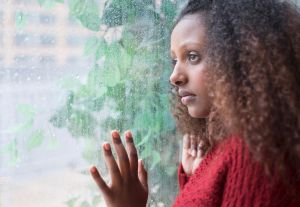
Source: JGI/Tom Grill / Getty
Sankofa is a symbol and concept that originated with the Akan people of West Africa. It teaches us to look to the past as we stand in the present and prepare for the future.
There is no better time to connect to the wisdom of Sankofa than now, as each of us scrambles to adjust to a new normal that is incalculably different than the world we knew before the COVID-19 pandemic. In many ways, it feels like the world is ending. And while we fight against this nation—and the world’s—desire to carry the social ills of yesterday into our new reality (see: racism, sexism, and our obsession with capitalist systems that perpetually harm us and the environment), we are grieving the loss of some traditions and rituals that were connected to our old lives.
Building new worlds while holding on to parts of past ones, is not a new experience for Black and Indigenous people; it is something that our elders and ancestors have had to do over and over again. In fact, if anyone can teach us how to grow a harvest from a scorched Earth, it is those who did this work before us.
The Living Altar, a new exhibition opening in June at the Museum of Contemporary African Diasporan Art (MoCADA), calls on us to take on the work of healing our relationships with ourselves, with one another and with the planet, and it asks us to imagine this work while connecting to historical and ancestral wisdom. This exhibition, curated by the multi-hyphenate creative and visionary Noni Limar, comes together through collaborations between the MoCADA, the Kalliopeia Foundation, the non-profit Soil and Shadow, and movement builders Blackird.
The Living Altar is a multi-sensory experience that is meant to remind us of what it feels like to sit at the feet of our elders—a practice that many of us have had to forgo during this global pandemic, and one that some of us have never had an opportunity to experience. Sitting with elders is a common practice in many Black and Indigenous cultures, as it has always been (and continues to be) a way to honor and pass down familial and communal histories and traditions. A starting point is to practice reconnecting our hearts and spirits with the land that has sustained us in the past and present (and hopefully in the future if we recommit to doing the work to save our planet).
Noni Limar seeks to bring a modern twist to centuries-old oral traditions while exploring our spiritual strivings and also ways that we can better connect to and save the planet in The Living Altar. She shares on the importance of creating the exhibition: “This audio / visual offering is a call for all of us to begin a deeper process of centering the impulses of spirit and needs of the earth into our culture of healing and resistance. We need more collective messages. More sound and less noise. More deep listening and heart expanding image. We need calls that feel restorative while still demanding that we show up in all of our glory.”
The Living Altar brings together ecological futurists like author and creative Ibrahim Abdul-Matin whose work focuses on urging us to “renegotiate our relationship with the earth,” Tracy Lloyd McCurty, of the Acres of Ancestry Initiative/Black Agrarian Fund—an organization that defines itself as “a cooperative nonprofit ecosystem rooted in Black ecocultural traditions and textile arts,” and Toni Anderson—an urban ecologist and spiritualist, who is also the founder of Chicago’s Sacred Keepers Sustainability Lab. These creatives use their imaginations to help us identify all of the ways human beings are harming the planet, while also radicalizing us to transform our relationships with the environment and demand that corporations and government entities who are responsible for perpetuating environmental harm us and our communities do the same.
We cannot create conversations around environmental justice that do not address racism and white supremacy. Black and Indigenous communities are disproportionately affected by environmental issues like elevated temperatures, connected co-pollutant issues and natural disasters. In fact, according to a report produced by Saleem Chapman, who is the chief resilience officer for the City of Philadelphia, up to 71% of Black people live in counties that perpetually violate federal air pollution standards. As climate change makes surviving continual natural disasters a reality for Black and Indigenous people, we know that many of our folks are being violently uprooted from their communities and provided few resources to recover from these disasters. The Living Altar is a loving call to arms meant to remind us that it is our responsibility to defend the environment, and those among us who are most vulnerable to environmental issues.
The Living Altar meets beauty with urgency and fury. Nikki Silvestri, who is the founder of Soil and Shadow, speaks to why this moment and this exhibition is so precious and urgent, “Humans are in a catastrophe right now. This project asks us to pause and remember ways to move through catastrophe into wisdom, into patience and into our hearts. The artists have invited us into a community of care that I’m excited for others to experience through the exhibit.”
See artists featured in ‘The Living Altar’ below:
Sherry Williams
Claudia Ford
Orrin Williams
Dekera Greene
Rodriguez Jose
Luis Ortiz
Ibrahim Abdul-Matin
Kim Ruffin
Omar Brownson
Toni Anderson
Veronica Kyle
Tracy Lloyd McCurty
Nikki Silvestri
Valerie Rawls
















